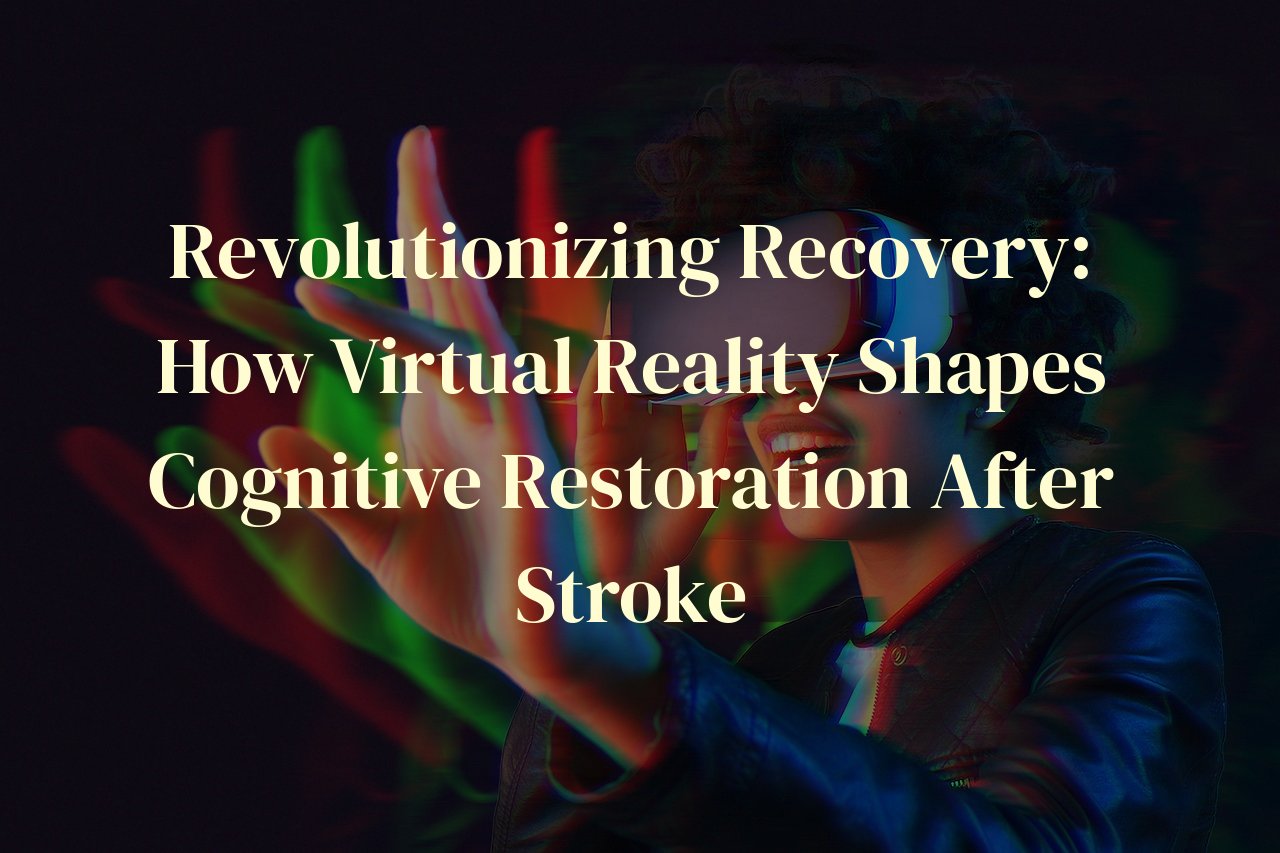
The intersection of technology and healthcare has ushered in a new era of rehabilitation strategies, punctuated by remarkable digital innovations. This post peels back the layers of one such technological marvel – virtual reality (VR) – and its transformative role in cognitive rehabilitation for individuals post-stroke. By navigating through the groundbreaking potential of VR to improve cognitive functions and overall quality of life, readers will gain insights into the benefits and applications of this cutting-edge tool in stroke recovery journeys.
You’re about to embark on a journey that will highlight how virtual environments are redefining recovery protocols, offering not just hope, but tangible progress to those seeking to reclaim their cognitive capabilities after a stroke. Prepare to be inspired by the stories of renewal and the science that empowers them.
Table of Contents
Understanding the Cognitive Aftermath of Stroke
The journey of recovery after a stroke is often as much about regaining cognitive function as it is about physical rehabilitation. Stroke, a cerebrovascular accident that can be ischemic or hemorrhagic, interrupts the blood flow to the brain, resulting in tissue damage and a host of cognitive disruptions. A stroke survivor may face challenges that include language difficulties, memory lapses, diminished problem-solving skills, and altered executive functions. Each individual’s experience is unique, governed by the stroke’s severity and the brain regions affected.
Language and communication hurdles post-stroke, known clinically as aphasia, can range from struggling to find words to more profound losses of the ability to comprehend or express language. Memories, both short and long-term, may be affected; some survivors find it difficult to encode new memories or recall past events. Problem-solving difficulties arise when the stroke impacts critical thinking pathways in the brain, demanding a relearning process for decision-making and the execution of complex tasks.
Furthermore, impairment in executive functions—those cognitive processes that enable us to plan, focus attention, remember instructions, and juggle multiple tasks—can be particularly incapacitating. Stroke survivors may find themselves easily distracted, unable to concentrate, or struggling with the organization of daily activities. Visuospatial deficits, where the perception of spatial relationships is compromised, can also present after stroke, disrupting navigation and the ability to judge distances.
Emotional disturbances greatly influence cognitive restoration as well. Post-stroke depression, anxiety, and changes in personality are not uncommon, influenced by both the psychological impact of the event and neurobiological changes resulting from brain injury. Cognitive fatigue is another critical facet of post-stroke recovery, as the damaged brain requires more effort to execute tasks that were once automatic, leading to exhaustion that impedes cognitive therapy.
Each of these cognitive challenges sets the stage for a complex rehabilitation journey. The goal is to facilitate neural plasticity—whereby the brain adapts, creating new pathways to compensate for those that have been damaged. This adaptive quality of the brain is a beacon of hope for stroke survivors, suggesting that with time, therapy, and targeted interventions like Virtual Reality (VR), cognitive functions can be progressively restored or compensated for, rekindling the sparks of independence and quality of life.
Demystifying Virtual Reality in Stroke Rehabilitation
Revolutionizing the pathway to recovery, Virtual Reality (VR) is emerging as a game-changer in stroke rehabilitation. At the core of its application is the remarkable versatility it offers, juxtaposed with cutting-edge technology. VR immerses patients in a controlled, interactive environment that can be tailored to address various cognitive deficits encountered post-stroke. This multifaceted approach provides a fertile ground for cognitive restoration, making seemingly insurmountable challenges more manageable and engaging.
Through the use of VR, therapists can transport patients into virtual settings that stimulate cognitive functions such as attention, memory, and problem-solving. This simulation of real-world tasks without the accompanying risks provides a safe space for repetition and practice, which is paramount for neuroplasticity—the brain’s ability to reorganize itself by forming new neural connections. The adaptable nature of VR therapy means that it can evolve with the patient’s progress, offering an individualized rehabilitation journey.
The interactive aspect of VR also plays a pivotal role in maintaining patient motivation. With features that allow for instant feedback and rewards, VR engages patients in their healing path, providing a sense of accomplishment and progress that can fight the discouragement often accompanying traditional rehabilitation methods. Furthermore, the excitement of navigating through a virtual world helps patients transcend the confines of their physical limitations, fostering a more profound psychological investment in their recovery.
Understanding the integration of Virtual Reality with rehabilitative strategies unveils the logistics behind its effectiveness. Advanced VR systems can track and record patient movements and responses, offering tangible data to healthcare providers. This feedback loop not only fine-tunes therapy sessions but also equips medical professionals with insights into cognitive improvements or setbacks, thus refining future treatment protocols.
Lastly, by demystifying the application of VR in stroke recovery, we shed light on its capacity to function not just as a therapy tool, but as a bridge to normalcy. The immersive experiences help desensitize survivors to anxiety-provoking stimuli, preparing them for real-life interactions. Such preparation aims to ultimately restore independence, elevate quality of life, and crystallize the notion that technology, indeed, can blend seamlessly with healthcare to restore the essence of what was momentarily lost.
Case Studies: VR’s Impact on Stroke Survivors’ Cognitive Recovery
Delving into the realm of cognitive restoration, virtual reality (VR) emerges as a beacon of innovation for stroke survivors wrestling with mental reconstruction. One profound illustration is the narrative of Eleanor, a septuagenarian whose stroke left her with impairments in memory and spatial awareness. VR therapy, in her case, didn’t merely engage; it transported her into a cosmos where rehab turned into a personalized adventure. Therapists crafted scenarios that mirrored Eleanor’s hobbies, which included gardening and navigating local markets. Through a tailored VR program, she practiced cognitive tasks like identifying plant species and calculating currency exchanges. Her progress was not just medically significant but emotionally invigorating, highlighting VR’s potential to blend healing with joy.
Another vivid testimony involves David, a middle-aged graphic designer, whose livelihood was threatened by a stroke-induced decline in concentration and problem-solving skills. VR unfolded as his cognitive gymnasium, where he embarked on intricate design tasks presented in a 3D canvas. The virtual environment was adeptly modified to challenge his intellect while tracking his cognitive milestones in real-time. As David manipulated virtual objects and navigated through complex spatial layouts, therapists observed noteworthy enhancements in his executive functions. The VR experience was a confluence of work and play, reinstating David’s professional capabilities in a landscape suffused with engagement and encouragement.
Lastly, the journey of Maya showcases VR’s role in surmounting language barriers post-stroke. Aphasia had marred her communication, but the interactive VR setting became her linguistic playground. A cacophony of virtual dialogues and puzzles tailored around common social interactions honed her language processing and verbal expression. With every VR session, Maya rediscovered words, gripping onto them fiercely as she reassembled her means to interact with the world around her. The episodic triumphs knit together a story of resilience, sculpted by a technology that defied traditional therapy confines.
The case studies underline not just VR’s effectiveness but its transformative power in redefining cognitive convalescence. These anecdotes are a testament to VR’s ability to foster environments where recovery is patient-centric, motivation-fueled, and hope-infused. Each stroke survivor’s journey, marked by VR-assisted recovery, artifacts an emergent understanding of how technology can shape not only outcomes but the very essence of the healing process. From individualized challenges to emotionally charged milestones, VR stands as an architect of custom, impactful, and compassionate cognitive rehabilitation pathways.
VR Rehabilitation Programs: Tailored Therapy Meets User Immersion
Innovative advancements in neurorehabilitation have ushered in an era where technology and therapy converge to create highly specialized treatment modalities. Virtual Reality (VR) rehabilitation programs stand at the forefront of this convergence, offering stroke survivors a compelling blend of tailored therapy and user immersion. These programs are designed to engage patients in a multifaceted environment that not only stimulates their cognitive functions but does so in a manner that fosters motivation and participation.
VR rehabilitation programs are predicated on the idea of neural plasticity, the brain’s ability to reorganize itself by forming new neural connections. By involving patients in virtual scenarios that mimic real-life activities, therapists can deliver personalized therapeutic experiences that align with each patient’s specific cognitive deficits. For instance, a program may incorporate memory games, problem-solving tasks, and puzzles that adapt in difficulty as the patient’s skill level progresses, ensuring an optimal challenge that encourages cognitive growth without being discouraging.
The immersive nature of VR provides a unique platform where users can interact with a controlled environment in real time. This sensory-rich medium harnesses the power of visual, auditory, and sometimes haptic feedback to strengthen cognitive engagement. For a stroke survivor grappling with attention deficits, VR tasks that require focus on particular stimuli can offer practice in a way that traditional worksheets or computer tasks cannot replicate. The immersion can result in heightened levels of concentration and thus, more effective rehabilitation outcomes.
Moreover, the versatility of VR rehabilitation allows for customization not just in cognitive domain but also in the aesthetics and narratives of the virtual worlds patients engage with. These worlds can be comforting, familiar settings that reduce anxiety and promote relaxation, which in turn can enhance cognitive recovery. Alternatively, the patient might be challenged to navigate novel environments, which can stimulate adaptability and problem-solving skills. This dual approach addresses the emotional and psychological well-being of the patient, acknowledging the intricate connection between mental health and cognitive recuperation.
In evaluating the success of VR programs, one must consider both qualitative and quantitative data. Clinicians look at metrics such as task completion times, error rates, and levels of task engagement to measure cognitive improvements. Equally important, however, are the subjective experiences of the patients—how they feel about the therapy, their levels of confidence in their abilities, and their willingness to continue with the therapy. These factors play a crucial role in recovery and are testament to the success of immersive, tailored VR rehabilitation programs.
To conclude, VR rehabilitation programs embody the nexus of tailored therapy and user immersion, offering a promising avenue for cognitive restoration post-stroke. By delivering bespoke therapeutic exercises in an engaging and motivating format, these programs have the potential to revolutionize recovery and provide hope to many who are on the journey to reclaiming their cognitive functions.
Evaluating the Success of VR Cognitive Rehabilitation
Evaluating the effectiveness of Virtual Reality (VR) in cognitive rehabilitation post-stroke is crucial to understanding both its therapeutic potential and areas for improvement. In assessing VR’s success, it is necessary to employ a multifaceted approach that looks at quantitative and qualitative variables that provide a holistic view of recovery.
One crucial aspect is the assessment of cognitive function improvements, which are quantitatively measured using standardized cognitive tests. These tests help in determining the progress in areas such as attention, memory, and executive functions. Improvement scores can be compared to baseline levels to gauge the patient’s advancements.
Qualitative measures are equally important, as they provide insights into the patient’s subjective experience. Patient feedback on the VR therapy’s engagement level, perceived benefits, and satisfaction contribute to understanding its acceptance. Moreover, subjective reporting can highlight how VR experiences support a sense of autonomy and motivation, which are key for continued practice and recovery.
The incorporation of neuroimaging techniques like fMRI or PET scans can visualize the changes in brain activity patterns, offering concrete evidence of neurological restoration. Such objective data not only validate cognitive improvements but also guide the evolution of VR therapy protocols to target specific neural mechanisms.
Long-term follow-ups on patients’ real-world functionality and independence are indicators of VR’s lasting impact. Observing how individuals reintegrate into their daily lives, manage complex tasks, and improve in occupational or social roles can paint a comprehensive picture of VR’s role in sustained cognitive recovery.
Lastly, a comparison of VR rehabilitation outcomes with those from traditional cognitive rehabilitation methods is necessary to contextualize VR’s effectiveness. Benchmarking against established therapies can reveal where VR excels or requires enhancement, steering future developments in therapeutic VR technologies.
Conclusion
In the dynamic landscape of healthcare, virtual reality emerges not just as a tool, but as a beacon of innovation guiding the way to more effective cognitive rehabilitation for stroke survivors. The power of VR lies in its ability to create engaging, tailored experiences that can lead to significant strides in cognitive function. Whether it’s enhancing memory, attention, or problem-solving skills, VR is reshaping what’s possible in post-stroke care. The future looks promising, with VR leading the charge in a journey of transformation and renewed hope for individuals navigating the road to recovery.



